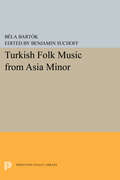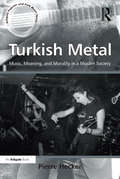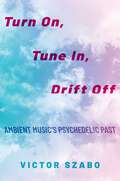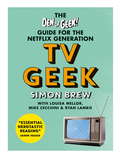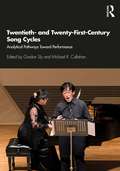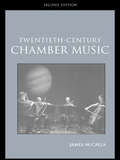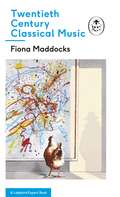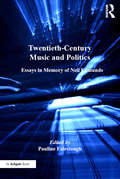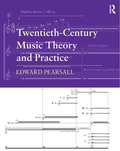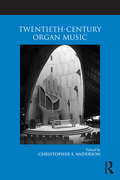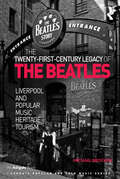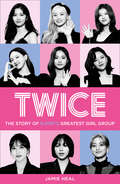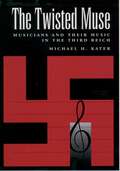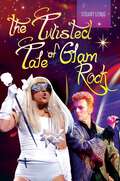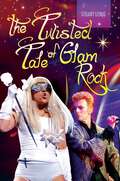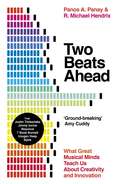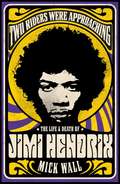- Table View
- List View
Turkish Folk Music from Asia Minor
by Bela Bartok Benjamin SuchoffThis book is a substantial and thorough musicological analysis of Turkish folk music. It reproduces in facsimile Bartók's autograph record of eighty seven vocal and instrumental peasant melodies of the Yürük Tribes, a nomadic people in southern Anatolia. Bartók's introduction includes his annotations of the melodies, texts, and translations and establishes a connection between Old Hungarian and Old Turkish folk music.Begun in 1936 and completed in 1943, the work was Bartók's last major essay. The editor, Dr. Benjamin Suchoff, has provided an historical introduction and a chronology of the various manuscript versions. An afterword by Kurt Reinhard describes recent research in Turkish ethnomusicology and gives a contemporary assessment of Bartók's field work in Turkey. Appendices prepared by the editor include an index of themes compiled by computer.Originally published in 1976.The Princeton Legacy Library uses the latest print-on-demand technology to again make available previously out-of-print books from the distinguished backlist of Princeton University Press. These editions preserve the original texts of these important books while presenting them in durable paperback and hardcover editions. The goal of the Princeton Legacy Library is to vastly increase access to the rich scholarly heritage found in the thousands of books published by Princeton University Press since its founding in 1905.
Turkish Metal: Music, Meaning, and Morality in a Muslim Society (Ashgate Popular and Folk Music Series)
by Pierre HeckerTurkish Metal journeys deep into the heart of the Turkish heavy metal scene, uncovering the emergence, evolution, and especially the social implications of this controversial musical genre in a Muslim society. The book applies an ethnographic approach in order to study social and cultural change in a Muslim society that is stricken with conflict over the, by turns, religious or secular nature of the state. Turkish Metal explores how Turkish metalheads, against all odds, manage to successfully claim public spaces of their own, thereby transforming the public face of the city. The book raises the question of how and why the young dare to rebel against the prevalent social and moral restrictions in Turkish society; and it examines whether they succeed in asserting their individual freedom in a society that is still well-known for sanctioning any kind of behaviour deviating from the norm. Above all, the book investigates the Turkish metal scene's potential for contesting Islamic concepts of morality, its relevance within the field of female emancipation, and its capacity to foster social relations that cut across national, religious and ethnic boundaries.
Turkish Metal: Music, Meaning, and Morality in a Muslim Society (Ashgate Popular and Folk Music Series)
by Pierre HeckerTurkish Metal journeys deep into the heart of the Turkish heavy metal scene, uncovering the emergence, evolution, and especially the social implications of this controversial musical genre in a Muslim society. The book applies an ethnographic approach in order to study social and cultural change in a Muslim society that is stricken with conflict over the, by turns, religious or secular nature of the state. Turkish Metal explores how Turkish metalheads, against all odds, manage to successfully claim public spaces of their own, thereby transforming the public face of the city. The book raises the question of how and why the young dare to rebel against the prevalent social and moral restrictions in Turkish society; and it examines whether they succeed in asserting their individual freedom in a society that is still well-known for sanctioning any kind of behaviour deviating from the norm. Above all, the book investigates the Turkish metal scene's potential for contesting Islamic concepts of morality, its relevance within the field of female emancipation, and its capacity to foster social relations that cut across national, religious and ethnic boundaries.
Turn On, Tune In, Drift Off: Ambient Music's Psychedelic Past
by Victor SzaboTurn On, Tune In, Drift Off: Ambient Music's Psychedelic Past rethinks the history and socioaesthetics of ambient music as a popular genre with roots in the psychedelic countercultures of the late twentieth century. Victor Szabo reveals how anglophone audio producers and DJs between the mid-1960s and century's end commodified drone- and loop-based records as "ambient audio": slow, spare, spacious audio sold as artful personal media for creating atmosphere, fostering contemplation, transforming awareness, and stilling the body. The book takes a trip through landmark ambient audio productions and related discourses, including marketing rhetoric, artist manifestos and interviews, and music criticism, that during this time plotted the conventions of what became known as ambient music. These productions include nature sounds records, experimental avant-garde pieces, "space music" radio, psychedelic and cosmic rock albums, electronic dance music compilations, and of course, explicitly "ambient" music, all of which popularized ambient audio through vivid atmospheric concepts. In paying special attention to the sound of ambient audio; to ambient audio's relationship with the psychedelic, New Age, and rave countercultures of the US and UK; and to the coincident evolution of therapeutic audio and "head music" across alternative media and independent music markets, this history resituates ambient music as a hip highbrow framing and stylization of ongoing practices in crafting audio to alter consciousness, comportment, and mood. In so doing, Turn On, Tune In, Drift Off illuminates the social and aesthetic rifts and alliances informing one of today's most popular musical experimentalisms.
Turn On, Tune In, Drift Off: Ambient Music's Psychedelic Past
by Victor SzaboTurn On, Tune In, Drift Off: Ambient Music's Psychedelic Past rethinks the history and socioaesthetics of ambient music as a popular genre with roots in the psychedelic countercultures of the late twentieth century. Victor Szabo reveals how anglophone audio producers and DJs between the mid-1960s and century's end commodified drone- and loop-based records as "ambient audio": slow, spare, spacious audio sold as artful personal media for creating atmosphere, fostering contemplation, transforming awareness, and stilling the body. The book takes a trip through landmark ambient audio productions and related discourses, including marketing rhetoric, artist manifestos and interviews, and music criticism, that during this time plotted the conventions of what became known as ambient music. These productions include nature sounds records, experimental avant-garde pieces, "space music" radio, psychedelic and cosmic rock albums, electronic dance music compilations, and of course, explicitly "ambient" music, all of which popularized ambient audio through vivid atmospheric concepts. In paying special attention to the sound of ambient audio; to ambient audio's relationship with the psychedelic, New Age, and rave countercultures of the US and UK; and to the coincident evolution of therapeutic audio and "head music" across alternative media and independent music markets, this history resituates ambient music as a hip highbrow framing and stylization of ongoing practices in crafting audio to alter consciousness, comportment, and mood. In so doing, Turn On, Tune In, Drift Off illuminates the social and aesthetic rifts and alliances informing one of today's most popular musical experimentalisms.
TV Geek: The Den of Geek Guide for the Netflix Generation
by Simon BrewEssential nerdtastic reading! - Jason IssacsFrom the author of Den of Geek, this is the ultimate, nerdy television guide for TV geeks everywhere!TV Geek recounts the fascinating stories of cult-classic series, reveals the nerdy Easter eggs hidden in TV show sets, and demonstrates the awe-inspiring power of fandom, which has even been known to raise TV series from the dead. Includes:- How the live-action Star Wars TV show fell apart- The logistics and history of the crossover episode- The underrated geeky TV shows of the 1980s- The hidden details of Game of Thrones- Five Scandinavian crime thrillers that became binge hits - The Walking Dead, and the power of fandomTV series are now as big as Hollywood movies with their big budgets, massive stars, and ever-growing audience figures! TV Geek provides an insightful look at the fascinating history, facts and anecdotes behind the greatest (and not-so-great) shows.
Twentieth- and Twenty-First-Century Song Cycles: Analytical Pathways Toward Performance
by Gordon Sly Michael R. CallahanTwentieth- and Twenty-First-Century Song Cycles: Analytical Pathways Toward Performance presents analyses of fourteen song cycles composed after the turn of the twentieth century, with a focus on offering ways into the musical and poetic structure of each cycle to performers, scholars, and students alike. Ranging from familiar works of twentieth-century music by composers such as Schoenberg, Britten, Poulenc, and Shostakovich to lesser-known works by Van Wyk, Sviridov, Wheeler, and Sánchez, this collection of essays captures the diversity of the song cycle repertoire in contemporary classical music. The contributors bring their own analytical perspectives and methods, considering musical structures, the composers' selection of texts, how poetic narratives are expressed, and historical context. Informed by music history, music theory, and performance, Twentieth- and Twenty-First-Century Song Cycles offers an essential guide into the contemporary art-music song cycle for performers, scholars, students, and anyone seeking to understand this unique genre.
Twentieth- and Twenty-First-Century Song Cycles: Analytical Pathways Toward Performance
by Gordon Sly Michael R. CallahanTwentieth- and Twenty-First-Century Song Cycles: Analytical Pathways Toward Performance presents analyses of fourteen song cycles composed after the turn of the twentieth century, with a focus on offering ways into the musical and poetic structure of each cycle to performers, scholars, and students alike. Ranging from familiar works of twentieth-century music by composers such as Schoenberg, Britten, Poulenc, and Shostakovich to lesser-known works by Van Wyk, Sviridov, Wheeler, and Sánchez, this collection of essays captures the diversity of the song cycle repertoire in contemporary classical music. The contributors bring their own analytical perspectives and methods, considering musical structures, the composers' selection of texts, how poetic narratives are expressed, and historical context. Informed by music history, music theory, and performance, Twentieth- and Twenty-First-Century Song Cycles offers an essential guide into the contemporary art-music song cycle for performers, scholars, students, and anyone seeking to understand this unique genre.
Twentieth-Century Chamber Music
by James McCallaFirst Published in 2003. Routledge is an imprint of Taylor & Francis, an informa company.
Twentieth-Century Chamber Music
by James McCallaFirst Published in 2003. Routledge is an imprint of Taylor & Francis, an informa company.
Twentieth-Century Classical Music: A Ladybird Expert Book (The Ladybird Expert Series)
by Fiona MaddocksPart of the ALL-NEW LADYBIRD EXPERT SERIES.____________How did modern classical music develop over the 20th Century?What enabled women to get their music performed in the early 1900s?Which classical composers borrowed from jazz?How did composers respond to politics and war?DISCOVER the stories behind Mahler's, Symphony No. 5 (1901-2), Ullman's Piano Sonata No. 7 (1944), Bernstein's West Side Story (1957), as well as learn about minimalism, jazz, swing, opera . . . AND UNDERSTAND TWENTIETH CENTURY CLASSICAL MUSIC.Discover the answers and more inside Fiona Maddocks' Twentieth Century Classical Music, the thrilling and accessible account that explains what happened throughout the 20th century, who the key composers were and what influenced them to write what they did?
Twentieth-Century Music and Politics: Essays in Memory of Neil Edmunds
by Pauline FaircloughWhen considering the role music played in the major totalitarian regimes of the century it is music's usefulness as propaganda that leaps first to mind. But as a number of the chapters in this volume demonstrate, there is a complex relationship both between art music and politicised mass culture, and between entertainment and propaganda. Nationality, self/other, power and ideology are the dominant themes of this book, whilst key topics include: music in totalitarian regimes; music as propaganda; music and national identity; émigré communities and composers; music's role in shaping identities of 'self' and 'other' and music as both resistance to and instrument of oppression. Taking the contributions together it becomes clear that shared experiences such as war, dictatorship, colonialism, exile and emigration produced different, yet clearly inter-related musical consequences.
Twentieth-Century Music and Politics: Essays in Memory of Neil Edmunds
by Pauline FaircloughWhen considering the role music played in the major totalitarian regimes of the century it is music's usefulness as propaganda that leaps first to mind. But as a number of the chapters in this volume demonstrate, there is a complex relationship both between art music and politicised mass culture, and between entertainment and propaganda. Nationality, self/other, power and ideology are the dominant themes of this book, whilst key topics include: music in totalitarian regimes; music as propaganda; music and national identity; émigré communities and composers; music's role in shaping identities of 'self' and 'other' and music as both resistance to and instrument of oppression. Taking the contributions together it becomes clear that shared experiences such as war, dictatorship, colonialism, exile and emigration produced different, yet clearly inter-related musical consequences.
Twentieth-Century Music Theory and Practice
by Edward PearsallTwentieth-Century Music Theory and Practice introduces a number of tools for analyzing a wide range of twentieth-century musical styles and genres. It includes discussions of harmony, scales, rhythm, contour, post-tonal music, set theory, the twelve-tone method, and modernism. Recent developments involving atonal voice leading, K-nets, nonlinearity, and neo-Reimannian transformations are also engaged. While many of the theoretical tools for analyzing twentieth century music have been devised to analyze atonal music, they may also provide insight into a much broader array of styles. This text capitalizes on this idea by using the theoretical devices associated with atonality to explore music inclusive of a large number of schools and contains examples by such stylistically diverse composers as Paul Hindemith, George Crumb, Ellen Taffe Zwilich, Steve Reich, Michael Torke, Philip Glass, Alexander Scriabin, Ernest Bloch, Igor Stravinsky, Béla Bartók, Sergei Prokofiev, Arnold Schoenberg, Claude Debussy, György Ligeti, and Leonard Bernstein. This textbook also provides a number of analytical, compositional, and written exercises. The aural skills supplement and online aural skills trainer on the companion website allow students to use theoretical concepts as the foundation for analytical listening.Access additional resources and online material here: http://www.twentiethcenturymusictheoryandpractice.net and https://www.motivichearing.com/.
Twentieth-Century Music Theory and Practice
by Edward PearsallTwentieth-Century Music Theory and Practice introduces a number of tools for analyzing a wide range of twentieth-century musical styles and genres. It includes discussions of harmony, scales, rhythm, contour, post-tonal music, set theory, the twelve-tone method, and modernism. Recent developments involving atonal voice leading, K-nets, nonlinearity, and neo-Reimannian transformations are also engaged. While many of the theoretical tools for analyzing twentieth century music have been devised to analyze atonal music, they may also provide insight into a much broader array of styles. This text capitalizes on this idea by using the theoretical devices associated with atonality to explore music inclusive of a large number of schools and contains examples by such stylistically diverse composers as Paul Hindemith, George Crumb, Ellen Taffe Zwilich, Steve Reich, Michael Torke, Philip Glass, Alexander Scriabin, Ernest Bloch, Igor Stravinsky, Béla Bartók, Sergei Prokofiev, Arnold Schoenberg, Claude Debussy, György Ligeti, and Leonard Bernstein. This textbook also provides a number of analytical, compositional, and written exercises. The aural skills supplement and online aural skills trainer on the companion website allow students to use theoretical concepts as the foundation for analytical listening.Access additional resources and online material here: http://www.twentiethcenturymusictheoryandpractice.net and https://www.motivichearing.com/.
Twentieth-Century Organ Music
by Christopher S. AndersonThis volume explores twentieth-century organ music through in-depth studies of the principal centers of composition, the most significant composers and their works, and the evolving role of the instrument and its music. The twentieth-century was a time of unprecedented change for organ music, not only in its composition and performance but also in the standards of instrument design and building. Organ music was anything but immune to the complex musical, intellectual, and socio-political climate of the time. Twentieth-Century Organ Music examines the organ's repertory from the entire period, contextualizing it against the background of important social and cultural trends. In a collection of twelve essays, experienced scholars survey the dominant geographic centers of organ music (France, the Netherlands, Scandinavia, the United States, and German-speaking countries) and investigate the composers who made important contributions to the repertory (Reger in Germany, Messiaen in France, Ligeti in Eastern and Central Europe, Howells in Great Britain). Twentieth-Century Organ Music provides a fresh vantage point from which to view one of the twentieth century's most diverse and engaging musical spheres.
Twentieth-Century Organ Music
by Christopher S. AndersonThis volume explores twentieth-century organ music through in-depth studies of the principal centers of composition, the most significant composers and their works, and the evolving role of the instrument and its music. The twentieth-century was a time of unprecedented change for organ music, not only in its composition and performance but also in the standards of instrument design and building. Organ music was anything but immune to the complex musical, intellectual, and socio-political climate of the time. Twentieth-Century Organ Music examines the organ's repertory from the entire period, contextualizing it against the background of important social and cultural trends. In a collection of twelve essays, experienced scholars survey the dominant geographic centers of organ music (France, the Netherlands, Scandinavia, the United States, and German-speaking countries) and investigate the composers who made important contributions to the repertory (Reger in Germany, Messiaen in France, Ligeti in Eastern and Central Europe, Howells in Great Britain). Twentieth-Century Organ Music provides a fresh vantage point from which to view one of the twentieth century's most diverse and engaging musical spheres.
The Twenty-First-Century Legacy of the Beatles: Liverpool and Popular Music Heritage Tourism (Ashgate Popular and Folk Music Series)
by Michael BrockenIt has taken Liverpool almost half a century to come to terms with the musical, cultural and now economic legacy of the Beatles and popular music. At times the group was negatively associated with sex and drugs images surrounding rock music: deemed unacceptable by the city fathers, and unworthy of their support. Liverpudlian musicians believe that the musical legacy of the Beatles can be a burden, especially when the British music industry continues to brand the latest (white) male group to emerge from Liverpool as ’the next Beatles’. Furthermore, Liverpudlians of perhaps differing ethnicities find images of ’four white boys with guitars and drums’ not only problematic in a ’musical roots’ sense, but for them culturally devoid of meaning and musically generic. The musical and cultural legacy of the Beatles remains complex. In a post-industrial setting in which both popular and traditional heritage tourism have emerged as providers of regular employment on Merseyside, major players in what might be described as a Beatles music tourism industry have constructed new interpretations of the past and placed these in such an order as to re-confirm, re-create and re-work the city as a symbolic place that both authentically and contextually represents the Beatles.
The Twenty-First-Century Legacy of the Beatles: Liverpool and Popular Music Heritage Tourism (Ashgate Popular and Folk Music Series)
by Michael BrockenIt has taken Liverpool almost half a century to come to terms with the musical, cultural and now economic legacy of the Beatles and popular music. At times the group was negatively associated with sex and drugs images surrounding rock music: deemed unacceptable by the city fathers, and unworthy of their support. Liverpudlian musicians believe that the musical legacy of the Beatles can be a burden, especially when the British music industry continues to brand the latest (white) male group to emerge from Liverpool as ’the next Beatles’. Furthermore, Liverpudlians of perhaps differing ethnicities find images of ’four white boys with guitars and drums’ not only problematic in a ’musical roots’ sense, but for them culturally devoid of meaning and musically generic. The musical and cultural legacy of the Beatles remains complex. In a post-industrial setting in which both popular and traditional heritage tourism have emerged as providers of regular employment on Merseyside, major players in what might be described as a Beatles music tourism industry have constructed new interpretations of the past and placed these in such an order as to re-confirm, re-create and re-work the city as a symbolic place that both authentically and contextually represents the Beatles.
Twice: The Story Of K-pop's Greatest Girl Group
by Jamie HealIn the space of just five years, Twice have taken the K-Pop world by storm.
The Twisted Muse: Musicians and Their Music in the Third Reich
by Michael H. KaterIs music removed from politics? To what ends, beneficent or malevolent, can music and musicians be put? In short, when human rights are grossly abused and politics turned to fascist demagoguery, can art and artists be innocent? These questions and their implications are explored in Michael Kater's broad survey of musicians and the music they composed and performed during the Third Reich. Great and small--from Valentin Grimm, a struggling clarinetist, to Richard Strauss, renowned composer--are examined by Kater, sometimes in intimate detail, and the lives and decisions of Nazi Germany's professional musicians are laid out before the reader. Kater tackles the issue of whether the Nazi regime, because it held music in crassly utilitarian regard, acted on musicians in such a way as to consolidate or atomize the profession. Kater's examination of the value of music for the regime and the degree to which the regime attained a positive propaganda and palliative effect through the manner in which it manipulated its musicians, and by extension, German music, is of importance for understanding culture in totalitarian systems. This work, with its emphasis on the social and political nature of music and the political attitude of musicians during the Nazi regime, will be the first of its kind. It will be of interest to scholars and general readers eager to understand Nazi Germany, to music lovers, and to anyone interested in the interchange of music and politics, culture and ideology.
The Twisted Tale of Glam Rock
by Stuart LenigCovering four decades of music history, this engaging book explores a genre of pop music that has been overlooked, under-reported, and ineffectively characterized—but which nevertheless remains immensely popular.The very qualities that made glam unusual and undervalued are now being reintroduced into our culture through video, music, and cyber and computer mediums, while artists such as Lady Gaga have made glam popular once more. Carefully explaining this misunderstood genre, The Twisted Tale of Glam Rock explores glam's attraction and the reasons it has endured.With the help of copious examples, the book covers the style from the pre-glam British invasion of 1964-69 through the classical glam era (1970-75); the metamorphosis into glam goth, glam metal, and glam new-romanticism (1976-90); and the style's reemergence (1990-present). It provides a theoretical basis for musicians' attraction to this highly visual and theatrical form of pop music and sets glam in a historical context, following the format through MTV, videos, and vibrant stage and theatre presentations. Finally, the book explores the hybridization of glam with other styles, illustrating how the genre has progressively reemerged as a premier form of performance pop.
The Twisted Tale of Glam Rock
by Stuart LenigCovering four decades of music history, this engaging book explores a genre of pop music that has been overlooked, under-reported, and ineffectively characterized—but which nevertheless remains immensely popular.The very qualities that made glam unusual and undervalued are now being reintroduced into our culture through video, music, and cyber and computer mediums, while artists such as Lady Gaga have made glam popular once more. Carefully explaining this misunderstood genre, The Twisted Tale of Glam Rock explores glam's attraction and the reasons it has endured.With the help of copious examples, the book covers the style from the pre-glam British invasion of 1964-69 through the classical glam era (1970-75); the metamorphosis into glam goth, glam metal, and glam new-romanticism (1976-90); and the style's reemergence (1990-present). It provides a theoretical basis for musicians' attraction to this highly visual and theatrical form of pop music and sets glam in a historical context, following the format through MTV, videos, and vibrant stage and theatre presentations. Finally, the book explores the hybridization of glam with other styles, illustrating how the genre has progressively reemerged as a premier form of performance pop.
Two Beats Ahead: What Great Musical Minds Teach Us About Creativity and Innovation
by Panos A. Panay R. Michael Hendrix'A roadmap for innovators, entrepreneurs and those seeking new avenues for exploring and reimagining the future' Deepak Chopra 'Groundbreaking' Amy Cuddy, bestselling author of Presence Musicians know how to stay ahead of the beat. As Chance the Rapper said 'Technology moves faster than business and music moves faster than technology.' Forced to find new ways to adapt to accelerating change, musicians are masters of innovation. Demystifying their process for the first time, Two Beats Ahead reveals what we can learn from today's top musical minds. Drawing from interviews and case studies with masterminds like Quincy Jones, Jimmy Iovine, Dr. Dre, Lady Gaga, Beyoncé and Pharrell Williams, as well as leaders at Google X and Amazon, this book identifies the key lessons and skills musicians can teach us about innovation. Inspired by creative geniuses, you'll learn how to:· Listen more carefully and thoughtfully · Experiment more freely · Collaborate with a more diverse cast of partners· Demo and prototype like a jazz musician · Perform under the spotlight· Improvise like a great bebop ensemble Two Beats Ahead is a creativity crash-course for anyone who wants to be more entrepreneurial or lead an innovative team.'Inspiration for anyone looking to expand the reach of their creativity' Tim Brown, author of Change By Design'Based on their course at Berklee, Michael and Panos show that a musician's perspective, much like a designers perspective, can unlock inspiration and innovation, no matter who you are' David Kelley, founder of IDEO and the Stanford d.school
Two Riders Were Approaching: The Life & Death of Jimi Hendrix
by Mick WallJimmy was a down-at-heel guitarist in New York, relying on his latest lovers to support him while he tried to emulate his hero Bob Dylan. A black guy playing white rock music, he wanted to be all things to all people.But when Jimmy arrived in England and became Jimi, the cream of swinging London fell under his spell. It wasn't that Jimi could play with his teeth, play with his guitar behind his back. It was that he could really play.Journeying through the purple haze of idealism and paranoia of the sixties, Jimi Hendrix was the man who made Eric Clapton consider quitting, to whom Bob Dylan deferred on his own song 'All Along the Watchtower', who forced Miles Davis to reconsider his buttoned-down ways - and whose 'Star Spangled Banner' defined Woodstock. And when his star, which had burned so brightly, was extinguished far too young, his legend lived on in the music - and the intrigue surrounding his death. Eschewing the traditional rock-biography format, Two Riders Were Approaching is a fittingly psychedelic and kaleidoscopic exploration of the life and death of Jimi Hendrix - and a journey into the dark heart of the sixties. While the groupies lined up, the drugs got increasingly heavy and the dream of the sixties burned in the fire and blood of the Vietnam War, the assassination of Martin Luther King and the election of President Richard Nixon. Acclaimed writer Mick Wall, author of When Giants Walked the Earth, has drawn upon his own interviews and extensive research to produce an inimitable, novelistic telling of this tale - the definitive portrait of the Guitar God at whose altar other guitar gods worship.Jimi Hendrix's is a story that has been told many times before - but never quite like this.
